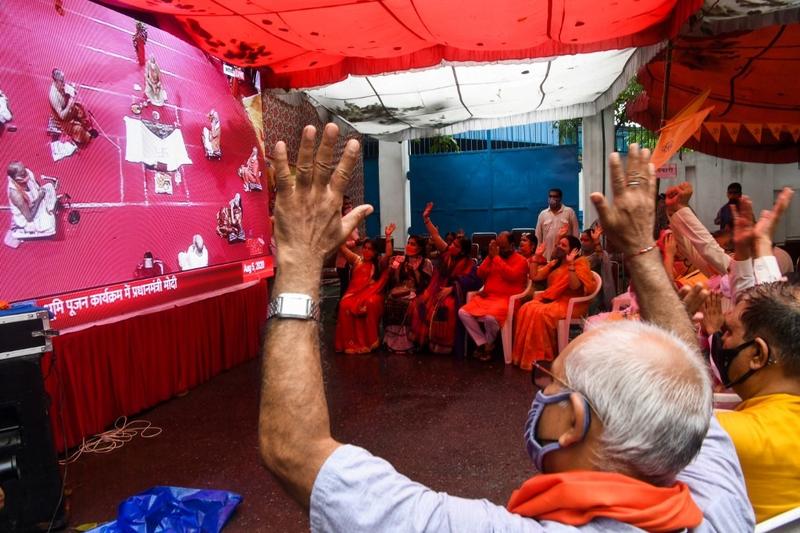 People watch a live telecast on a screen from Ayodhya of India's Prime Minister Narendra Modi taking part in a Hindu religious ritual during a groundbreaking ceremony of the Ram Temple, in New Delhi on August 5, 2020. (PRAKASH SINGH / AFP)
People watch a live telecast on a screen from Ayodhya of India's Prime Minister Narendra Modi taking part in a Hindu religious ritual during a groundbreaking ceremony of the Ram Temple, in New Delhi on August 5, 2020. (PRAKASH SINGH / AFP)
NEW DELHI / AYODHYA - Indian Prime Minister Narendra Modi on Wednesday laid the foundation stone of a grand temple dedicated to Lord Ram in Ayodhya, a town in northern state of Uttar Pradesh.
The PM's presence at the foundation stone laying ceremony attracted severe criticism from a section of Indian society
Ayodhya is considered as the birth place of Lord Ram. It is believed that Lord Ram was born here thousands of years ago.
The PM's presence at the foundation stone laying ceremony attracted severe criticism from a section of Indian society. According to Asaduddin Owaisi, a Muslim lawmaker from southern state of Telangana, Modi should not have taken part in this ceremony in the capacity of PM as India is a secular country.
A section of media also criticized Modi for participating in the ceremony. Deccan Herald, an English daily widely read in southern India, carried an article on Wednesday titled -- "Inappropriate for a PM to be associated with the stone laying ceremony."
ALSO READ: Two Muslims to grace Hindu temple ceremony on contested India site
The temple will have five domes with intricate carvings. It will be a three-floor structure with a height of 161 feet. It will be constructed at a site, an area of around 2.77 acres, that was bitterly contested between the people belonging to Muslim and Hindu communities for hundreds of years.
Till December 1992, there existed a mosque -- Babri Masjid at the same spot, which the Hindus believe was constructed by emperor Babar after razing a Ram temple which originally existed there.
Babar, originally hailing from central Asia, invaded India over 500 years ago. As per the historical records, he captured Delhi and founded the Mughal Empire, considered as the greatest dynasty of north-India.
ALSO READ: India's top court hands bitterly disputed Ayodhya site to Hindus
The "Ayodhya Land Dispute Case" between the Hindus and the Muslims was one of the longest pending cases in the country.
In a landmark judgment in November last year, the Supreme Court allowed the construction of Ram Temple at the disputed site, saying the Muslims will be given an alternate five-acre land for building a mosque.
READ MORE: India's top court dismisses all review petitions in Ayodhya verdict
Numerous security officials guarded Ayodhya, crowded by thousands of people, few wearing masks against the coronavirus, although social distancing measures to limit its spread will allow only about 200 to gather at the main event site.
The chant of prayers resounded through the city, located about 687 km (427 miles) southeast of the capital New Delhi, as devotees and monks thronged its numerous ancient temples in celebration.
Event organizers gathered soil from more than 2,000 holy spots and water from over 100 rivers for use in prayers at the start of the building work, while a Ram devotee from southern Tamil Nadu state has donated two bricks of precious metal.
With Reuters inputs


